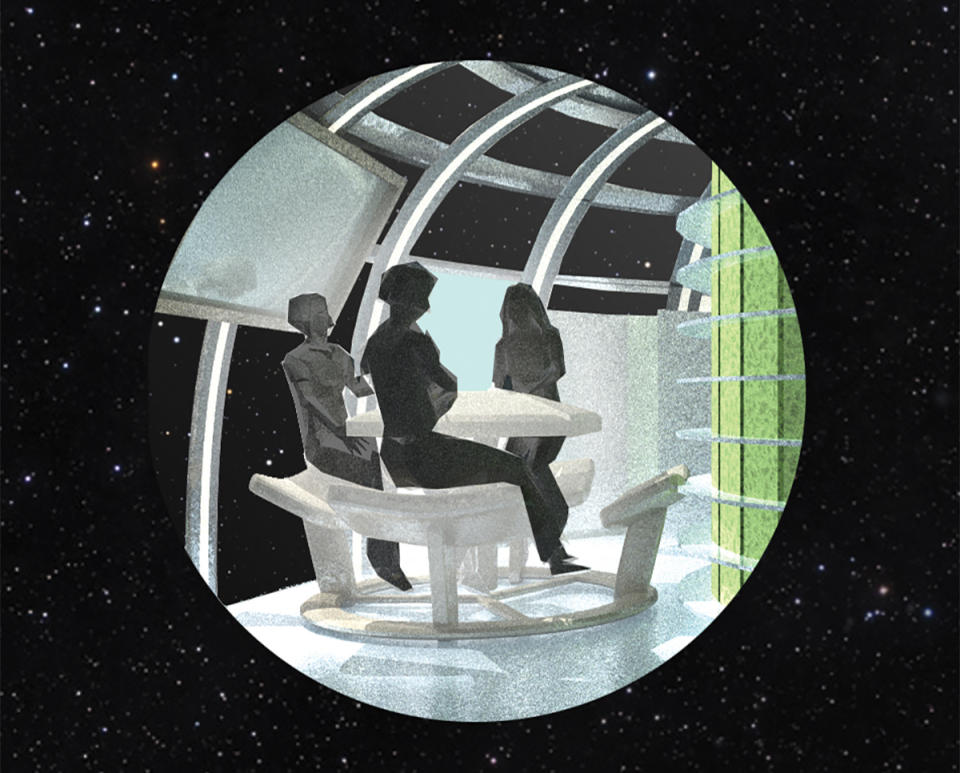As NASA plans to retire the International Space Station (ISS) at the end of the decade, the next generation of orbital business prepares to launch. Rocket-builder Blue Origin is aiming to have its first commercial space – a solar-powered, “mixed-use business park” called Orbital Reef – operating by 2030.
Floating 311 miles above Earth, the 29,300-cubic-foot installation will be self-sustaining and feature sleeping quarters, social spaces, and research facilities. Its central Core structure, with a volume of 8,228 cubic feet, is connected to an inflatable Large Integrated Flexible Environment (LIFE) habitat from Sierra Space, a Colorado-based aerospace and space-technologies outfit.
More from the Robb Report
The first version will accommodate up to 10 scientists, international astronomers, and tourists, who will be transported back and forth through multiple craft. As for the modular Tinkertoy design, it allows Orbital Reef to expand into a much larger camp over time. Here’s a glimpse of what life in low-Earth orbit would be like.
Walking in the Dark

One of the most exciting opportunities available to astro-tourists will be space travel. Although the capsule they will be trapped in resembles a robot from Lost in Space, its life support systems and large interior make it more comfortable than a standard space suit while still offering a unique view of Earth.
Growing Problems

One of the LIFE locations will have a hydroponic Astro Garden to provide staff members with fresh produce when they need a break from frozen meals. Sierra Space tested a self-contained “plant pillow”—a Teflon-lined bag made of Nomex and Kevlar—that contains water, fertilizer, and other growing materials to make it easier to harvest vegetables. “A lot of work goes into getting new food into space,” says Angie Wise, Sierra Space’s chief security officer. “If we’re going to Mars eventually, we’re going to have to learn to grow our own.”
The Ultimate Zoom Background

This 10,594-cubic-foot LIFE residence is where all community interaction will take place, with its bathroom and dining, sleeping, and fitness facilities. Plans show table-like tables, with fresh vegetables around the walls, and the ability to imagine video calls with Earth (among many technological advances, the space station will also have Wi-Fi). Admittedly, bunking is going to be important in the Orbital Reef launch: the installation setup at Sierra Space headquarters points to a hammock attached to the roof, requiring you to get in for some zero-gravity z’s.
Rooms With Views

Early designs for Orbital Reef feature private accommodations, but the long-term plan is for hotel accommodations. Tourists looking to pass the time productively can choose to participate in ongoing research programs or perhaps get some exercise, as exercise prevents the kind of bone loss that occurs over a long period of inactivity. Others may be content to simply admire the ever-changing view, as the space station completes 16 orbits per day.
Higher Education

As a destination for scientists to conduct research in microgravity, Orbital Reef will have two-tier labs—8,200 cubic feet in total—to conduct hundreds of experiments that could range from 3-D printing of human organs to creating energy-enhancing batteries. today’s electric car models are 10 times more expensive. Scientific equipment on hand includes incubators, freezers, bio-fabrication banks, and centrifuges.
The best of the Robb Report
Sign up for RobbReports’s Newsletter. For the latest news, follow us on Facebook, Twitter, and Instagram.
Click here to read the full article.
#Jeff #Bezoss #Blue #Origin #Commercial #Space #Station #Running